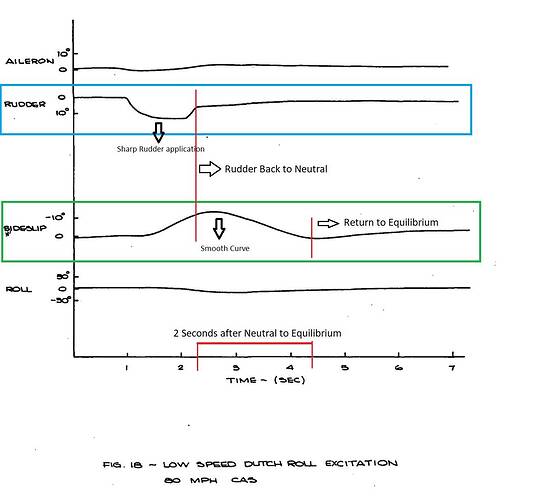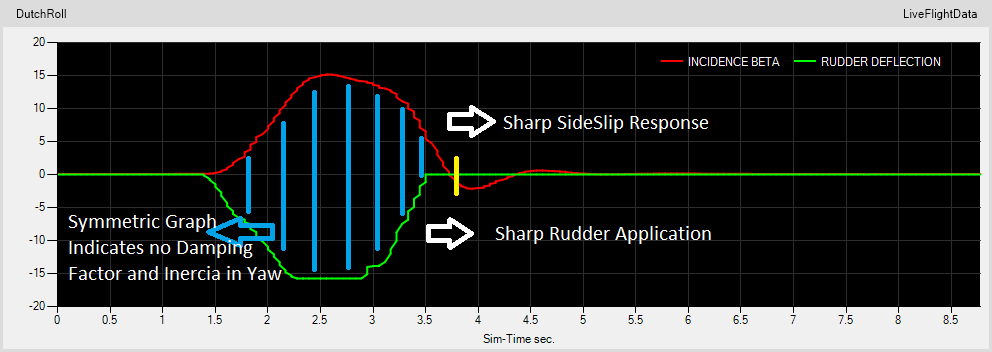I started on a little Journey trying to understand why MFS Flight Model currently behaves in a way so criticized across the Forums by many users as Arcade Feeling. Luckly, I have found some real Flight-Testing Reports on General Aviation Airplanes across the Internet that has been very helpful in helping me try to mitigate the origins of these controversial opinions.
After reviewing Nasa Flight Test Data for the Cessna Cardinal, I went to replicate the same Experiment in MFS2020. While the Cessna Cardinal (Empty Weight 1,533 lbs.) used on the real Flight Test is not available in MFS, the Cessna 172 (Empty Weight 1600lbs.) will be used as substitute. Data was Extracted with the excellent tool LiveFlightData from ThomW, which also Plots them on a Graph.
The First Graph demonstrates a Dutch Roll Inducing maneuver, which is basically Sharp Rudder Application, keeping Wings Levels, going back to Neutral after a Second, and letting the Airplane Return to Equilibrium with no interference.
The two most important lines to look at are the Rudder Surface Position in Degrees (Actual Surface, Not Pedal Position), and SideSlip Angle (Sideslip angle relates the displacement of the airplane centerline from the relative wind), both being displayed referenced by time elapsed in seconds. The advantage of Actual Rudder Surface Position vs Rudder Pedal Position is that we do not need to consider the Sensitivity Setting in MFS2020 Controller, as doesn’t matter how the Rudder Pedal Position is transferred to the Sim, as long as the actual Rudder Surface Position Matches the Graph.
We can observe how in the Real Plane, the Pilot do a sharp application of Rudder to Full Deflection for one second and back to neutral, yet the Sideslip Angle line describe a smooth Linear increase until Max value, then comes back down the same way, with duration over twice that of rudder application. This is due to Factors that acts as Damping in Maneuvering Stability, preventing an Abrupt and Immediate Reaction from a Control Deflection (You can read more about this on pg. 268 from Aerodynamics for Naval Aviators). This affects Yaw as well as in Pitching Moments. Inercia of course also plays a role here, the smaller the mass, the more immediate the reactions from the Controls Displacements. Greater mass on the other hand, slower responses. This will directly affect how long it takes to return to equilibrium after Rudder goes back to Neutral.
Now, I did the same Experiment on the Cessna 172 in MFS2020.
When I saw the Graph, I immediately understood why everyone complains on MFS Flight Model having Arcade Feeling. Let me first say I have great admiration on what was accomplished so far from the Asobo Team in many areas, including Aerodynamics. The Evolution from previous Table Based FM in FSX/P3D is evident wherever you look, and I never considered going back to those Simulators! This is written with 100% Desire to help improve Microsoft Flight Simulator.
Now, as one can easily see on the Graph, SideSlip Angle Matches almost perfectly the Rudder Position, almost a like a Duplicate mirrored. This demonstrate a complete Lack of Damping Factors after Control Displacement, generating an Aircraft Reaction almost like we were in a Vacuum, reminded me of what I would expect in a Space Sim, where there is no Air to be in the way of our intended Action.
Inercia basically does not play any role here neither, as the airplane doesn’t seem to have any problem dealing with Mass, Tracking the Movement of the Rudder simultaneously, and coming back to equilibrium with barely any delay or overshoot.
To exclude this being a matter of flying a bigger plane, or Tweaking of the flightmodel.cfg, I tried both, with the TBM930, and also reducing YawStability to the minimum of =0.01, no significant improvement was noted, as this is an issue to the Core Flight Model, affecting all Airplanes.
While the experiments were done around the Yaw Axis, the Pitch Axis shows similar Results, as the Physics are basically the same, both deal with Airfoils generating a Lift Vector after a Control Input.
This is in my opinion an area that Asobo’s Flight Model Team needs to focus, as it is the main responsible for so many of user criticism of Airplanes having Simplified, Arcade Flying Reactions and Feeling. This is something people don’t need to study or become a Pilot to expect from Flying a real plane, same as a young gamer can differentiate a realistic Car Racing Sim to an Arcade Game with no previous Driving Experience. It’s something we all expect from dealing with Physics.
Sincerely hope this helps anyhow!

